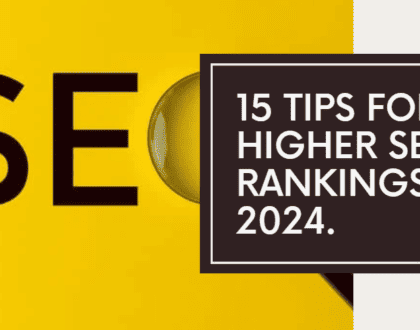How to Make Sure Your Startup SEO is Working

Search Engine Optimization (SEO) is one of the key factors for online presence.
Most startup owners are aware of Google’s power to make businesses rise and fall. But what many of them don’t know is how to approach SEO.
Before spending money on content marketing, social media, or SEO optimization, try walking a mile in Google’s shoes.
According to Google, the purpose of all their algorithms is to make their users happy.
What makes Google users happy?
It could be finding the song that they heard on the radio. Maybe all the searcher could remember from it is “we don’t need no education.” The search engine is responsible for figuring out the rest.
If the user doesn’t find the answer to their question, they’ll look to another search engine.
SEO, in a nutshell, should be about optimized content that delights the website visitor. This is all Google cares about: making their users happy.
Sure, there are many algorithms and techniques that help you rank better. However, all have one purpose: letting Google know that your website is high quality.
All things considered, since Google looks for the best from the very best, a startup SEO strategy should be a marathon, not a sprint.
What the Marathon Startup SEO Looks Like
A startup SEO strategy usually begins with on-page optimization and posting regularly on your blog.
Many SEO companies offer big promises. But the truth is that nobody can get you on the front page in only two months, no matter how expensive their service is.
You can outsource content creation. From the beginning, however, you should decide what keywords you want to target, and how you are going to implement your strategy.
At first, you shouldn’t focus on backlinks. Just create high-quality content and pick the right keywords.
In phase 2, you can start pitching to influential bloggers who cover topics that overlap with your area of interest. If your content is high quality, you will be easily accepted to write a guest post on their website.
Make sure to ask if they accept backlinks.
The 3 Step Guide on How to Approach Startup SEO
Since startup SEO is all about bootstrapping, outsourcing, and using methods that aren’t expensive yet effective, your focus should be a steady, slow journey towards ranking high.
Before you start crafting your startup SEO strategy, you should learn about the factors that have the highest impact on your ranking.
The top 10 factors that impact your startup SEO
- Backlinks
- Domain age, keywords, registration length, history, etc
- High-quality, long-form content
- User interaction and user experience (e.g., website design, ease to use, mobile friendliness, etc.)
- Sitemaps
- Responsive web design
- Social SEO (i.e., strong presence on social media)
- Low bounce rates and comments on your blog post
- Local SEO
- Meta tags
How to Get Started
Create a startup SEO strategy based on your current resources. How many writers do you have on your team? What about social media managers?
Is your website mobile friendly?
How much time can you invest daily in your SEO strategy?
Depending on how much time and resources you have, you can decide if your startup SEO strategy will focus on social SEO, content marketing, local SEO, or building backlinks.
Now, that you know which factors are important, you can move on to our 4 easy steps that will make your startup rank higher on Google with fewer resources.
1. The Skyscraper Technique: How to Beat Your Competitors Using Their Own Weapons
This strategy will not only help you stand out from your competitors, but also make your content impossible to ignore.
The first step is research. Use a keyword finder to learn which articles rank higher. Read your competitors’ articles and try to fill in the gaps.
How can you make their articles more engaging? What pieces of information are their articles missing?
Can you improve the visuals? Maybe you can create a better infographic, or a video with more relevant data.
The purpose of the skyscraper technique is to pick the highest ranking articles and write better versions of them.
This strategy transforms your content into a linkable asset. When your visitors see how complete your work is, they can’t help but link to it.
You will both prove your expertise and build backlinks.
The only downside to this technique is the cost.
High-quality articles are not easy to write. If you aren’t an experienced writer, it’s going to be pricey to find someone who can write the best article out there on a certain topic.
2. Social SEO-Connect and Build Social Backlinks
A cheap and easy way to increase your ranking and grow your traffic is social media.
A couple things to consider is 1) the effect that the age of the domain has on ranking, and 2) the popularity of social media platforms.
Often, the social media page of your business will rank higher than your website, despite the fact that your website is far more relevant than your Facebook page or Twitter profile.
To make sure you get the best out of social SEO, use keywords, images and videos to increase engagement and shares.
Social media also works like a search engine. Many people search their favorite brands on social media. Others search for companies they know nothing about, to make sure their existence is real.
If your business is a book, your presence on social media is the cover.
3. On-Page SEO
Often overlooked, on-page optimization is not only about keywords.
An SEO friendly article should follow these 8 rules:
- The header must contain the keyword you want to rank for
- Use the <h1> tag for the headline and the <h2> for sub headlines
- Use synonyms for your keyword
- Transform your headline into a long-tail keyword using modifiers like “best”, “ultimate guide”, “2017”
- Impress your readers with multimedia to decrease bounce rates
- Use your main keyword in the first 100 words
- Use external links from authoritative websites
- Sprinkle in some relevant internal links
Content that isn’t SEO optimized stands no chance in today’s online marketplace. Each of the steps mentioned above gives Google clues about the topic and the purpose of the content.
Without respecting these simple rules, your startup SEO strategy will fail to boost your rankings.
4. Hunt Down Influencers and Gain Backlinks-The Infographic Approach
This simple method will increase your odds of getting valuable backlinks, even if you’re only getting started.
Create a high-quality infographic. Make sure all the content inside the infographic is unique, informative, and backed by legitimate studies.
Search for influential bloggers in your niche, as well as content that would go well with your infographic.
Make a list of all the popular articles that touch the same topic as your infographic, but lack many visual elements.
Send the authors an email, showing your appreciation for their high-quality content, and ask them to take a look at your infographic.
Make sure to keep track of all the emails you sent, as well as your prospects, to avoid confusion.
Startup SEO Red Flags
Many startup owners have a hard time comprehending the importance of SEO. They focus on their business strategy and marketing. What they don’t know is that good SEO is like having a coffee shop in the town center.
If you aren’t in a place with high traffic, nobody will buy from you.
The desire to make rank high without effort turns many startups into easy prey for certain SEO companies.
Many SEO companies will tell you how it is to rank high within in a month or two—as long as you put money in their pockets, of course.
Real SEO experts don’t make promises like that. They know that it takes time to build credibility in the eyes of Google.
It also takes time to create content, distribute it on social media, and build backlinks.
Take a look at our list of SEO techniques you should avoid:
- Irrelevant keywords
- Keyword stuffing
- Cloaking
- Changing the content of a website after it ranks high
- Spammy blogs with content generated by software
- Domain squatting
- Spam on social media platforms
- Spamming forums
Many use the irrelevant keywords technique to drive traffic to their site. Someone searching for “Angelina Jolie”, won’t have an interest in your carpet cleaning services. Instead, they’re likely searching for information about Angelina.
Keyword stuffing involves repeating keywords as many times as possible to rank higher. However, this strategy is now penalized by Google, and the text is usually unreadable.
Cloaking is a technique that shows one type of content to the search engines, and a completely different type of content to website visitors.
Domain squatting is a technique in which someone profits from the name of a company or a public persona.
Black hat techniques lead to penalties, and they’re ineffective for boosting your business. Search engines want to index high-quality content, not spam.
Wrapping Up
Managing a startup SEO strategy isn’t easy. Nonetheless, it’s necessary for attracting more potential clients to your website. If you are beginning link building or seeking a simpler, smarter way to manage link building you can use a tool like Linkio.
If you want to find out more about what you should next to improve your rankings, don’t hesitate to take a look at our content marketing services or at our blog.
Recommended Posts

15 Most Important SEO Tips for Higher Rankings in 2024
March 12, 2024

Be Seen, Be Found: Supercharge Your Small Business with SEO
February 28, 2024

